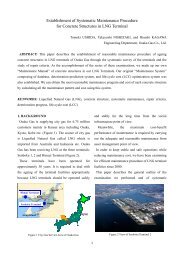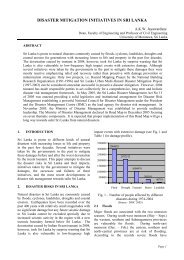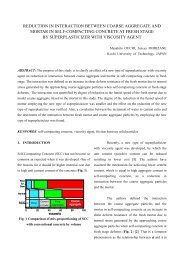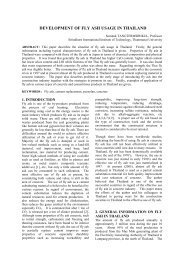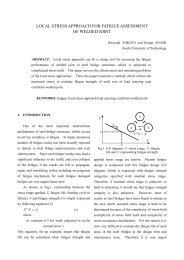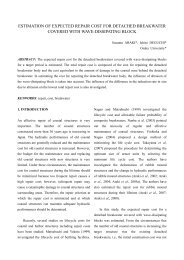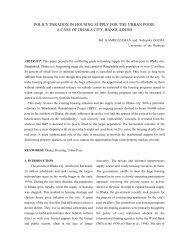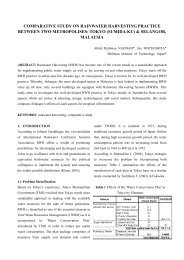Seismic Analysis of Water Supply Systems by Earthquake Scenario ...
Seismic Analysis of Water Supply Systems by Earthquake Scenario ...
Seismic Analysis of Water Supply Systems by Earthquake Scenario ...
Create successful ePaper yourself
Turn your PDF publications into a flip-book with our unique Google optimized e-Paper software.
pipe segment ends to A and B, respectively, (5) Add<br />
two new nodes A’ and B’ with the elevation <strong>of</strong> pipe<br />
break point and designate them as reservoirs, and<br />
finally (6) Add two new links connecting A-A’ and<br />
B-B’ and specify them with one-way check valves.<br />
Figure 5 Hydraulic model for a pipe leak (Cornell<br />
University, 2008)<br />
3. HYDRAULIC ANALYSIS AND NEGATIVE<br />
PRESSURE ISSUE<br />
Figure 4 Hydraulic model for a pipe break (Cornell<br />
University, 2008)<br />
On the other hand, a pipe leak and its hydraulic<br />
model could be depicted as the right schematic<br />
diagram in Figure 5. A pipe leak is hydraulically<br />
equivalent to a sprinkler with a specific discharge<br />
coefficient and an orifice size. This sprinkler is<br />
further proven to be equivalent to a fictitious pipe<br />
linking the original pipe and an added reservoir. A<br />
check valve is designated to the fictitious pipe<br />
ensuring that water flows from the leaking pipe to<br />
the reservoir. The steps to modify the hydraulic<br />
model <strong>of</strong> the leaking water system could be<br />
summarized as follows: (1) Decide the location and<br />
elevation <strong>of</strong> pipe leak point, (2) Remove the original<br />
link (pipe segment), (3) Add a new node A at the<br />
location <strong>of</strong> pipe leak point, (4) Add two new links<br />
connecting the original pipe segment ends to A, (5)<br />
Add a new node A’ with the elevation <strong>of</strong> pipe leak<br />
point and designate it as a reservoir, and finally (6)<br />
Add a new link connecting A and A’ and specify it as<br />
a fictitious pipe with a diameter <strong>of</strong> corresponding<br />
pipe leak model, and also specify it with a one-way<br />
check valve.<br />
Figure 6 depicts the schematic diagram <strong>of</strong> a<br />
simplified water network. A water network system<br />
usually consists <strong>of</strong> tanks, reservoirs, pumps, valves<br />
and numerous pipes and nodes. The hydraulics <strong>of</strong><br />
such a system can be assumed as pressurized pipe<br />
flows, and can be solved <strong>by</strong> using two sets <strong>of</strong><br />
equations (Rossman, 2000). Let there be N nodes,<br />
NF fixed nodes (e.g. tanks and reservoirs) and K<br />
pipes in a water network, then the first set prescribe<br />
the difference <strong>of</strong> water head at the ends <strong>of</strong> each pipe<br />
and read:<br />
H − H<br />
i<br />
j<br />
= h<br />
ij<br />
= r ⋅Q<br />
n<br />
ij<br />
+ m ⋅Q<br />
where H , h ,Q , r , n and m are the nodal head, head<br />
loss, flow rate, resistance coefficient, flow exponent<br />
and minor loss coefficient, respectively. The most<br />
widely used empirical formulae for the pipe<br />
resistance coefficient are the Darcy-Weisbach,<br />
Hazen-Williams or Chezy-Manning equation, all <strong>of</strong><br />
which employ flow rate and various pipe parameters.<br />
The second set prescribes the balance <strong>of</strong> flow at each<br />
node and read:<br />
∑<br />
j<br />
Q − D = 0<br />
ij<br />
i<br />
2<br />
ij



